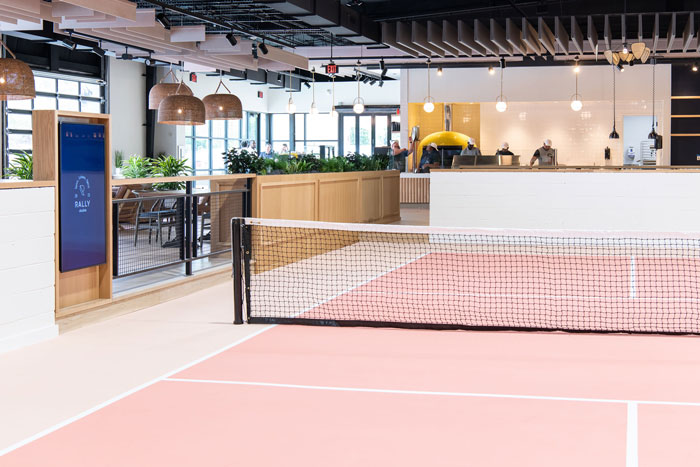Technological advances, innovations and analytics are driving the indoor sports surface manufacturing industry, creating multiple buying options for facility stakeholders to consider. Choosing the appropriate indoor surface can be a daunting task, said several manufacturers. But selecting the surface, whether wood or synthetics, for indoor sports and fitness activities can make all the difference at a facility, providing a pleasant aesthetic while improving safety and performance for guests and athletes.
When trying to decide what flooring is best suited for your facility, it is important to consider different attributes of each system, explained John Evans, technical director of the Maple Flooring Manufacturers Association (MFMA). “Always consider the following characteristics,” he said: “cost, appearance, elevation requirement, end users for the facility, and performance characteristics of the floor.”
Know your options, and understand their benefits and demerits. “Tradition leans to hardwood maple flooring with its
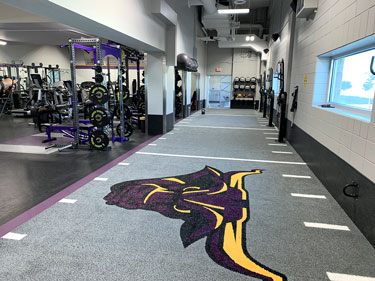
familiar appearance, durability and performance,” said Charlie Dwyer, marketing manager for a Philadelphia, Pa.- based athletic coverings, padding and mats manufacturer. “However, modern technology has made possible modular flooring that can, if needed, mimic the appearance of classic wood flooring while providing customizable performance and flexibility in terms of what it can be used for and what sports it supports.”
Other considerations include maintenance and upkeep, which is considerably less for modular flooring, along with expected lifetime, which is very long for traditional flooring.
Floor design can focus on a specific activity, added John Evans, technical director, MFMA. “Say, aerobics versus basketball or for multiple purposes to suit the exact need of a facility or application. Also, can the floor meet the specific needs of the users? Will the same floor be put in an elementary school, for gym class, lunch, stage and adult basketball at night? Will the floor be used by amateur athletes, or by professionals, who require the top level of performance by the sports surface?”
Another question: Is a synthetic floor an option, “or will you be installing a hardwood floor, such as maple?” Evans asked. “Time and again, athletes, performers, coaches, trainers, owners and architects who design floors cite maple as their preferred sports surface. Northern hard maple exhibits flexibility, resilience, durability, finish ability and low-demand maintenance.”
Flooring Options by Activities
Basketball in particular is traditionally associated with hardwood floors and has been played on that kind of surface since its invention in the 1890s. It is still the most popular flooring option for basketball due to its aesthetic and high shock resistance, and it is used at the highest level of the sport: the NBA and NCAA schools, said Amber Stromberg, marketing director for a Gurnee, Ill., athletic surface and installation contractor that represents flooring manufacturers.
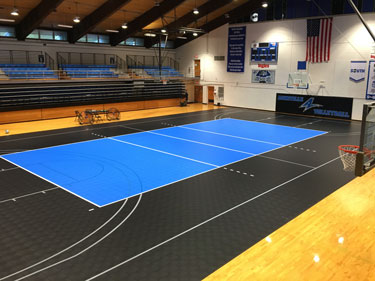
“But synthetic rubber sports flooring is also commonly used for basketball courts at schools and recreational facilities,” she added. “These flooring types are among the most durable and high-performing gymnasium floors available, and provide excellent shock absorption and energy return for athletic support and stability and better ball bounce.
“There is no preferred surface type for tennis, pickleball and padel (sometimes called padel tennis), as each floor offers slightly different performance,” Stromberg said. “Volleyball is traditionally played on wood flooring, which is durable and resilient while providing excellent support and ball bounce. Wood sports flooring also has a classic aesthetic and can incorporate the colors and logos of schools and facilities.”
Many facilities, however, opt for synthetic rubber flooring for volleyball, Stromberg noted. “Rubber sports flooring is manufactured with vulcanized rubber with shock-absorbing and energy return properties that provide stability and support for athletes.”
Pros and Cons
“There are pros and cons to both hardwood flooring (usually maple) and polyurethane flooring, although the former has been used for gyms for as long as most of us can remember,” said Dwyer. “There is no denying that traditional hardwood gym floors are beautiful when they have been well maintained and cared for. While there are many different shades and finishes that the hardwood floors come in and logos and lettering can be hand-painted on, the options and ease of customization are no match for modular tiles. Multiple colored tiles can easily be used in a single installation, and the color penetrates all the way through each unit, which means it can never wear off. Game lines and logos are painted on the surface after installation. For traditional flooring, this level of customization is only easily attainable through printed gym floor covers, and only for use in non-athletic events.”
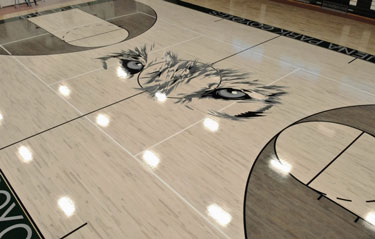
The first question that most people have about athletic flooring is the cost—both the initial cost and the long-term cost. The purchase and installation of flooring is a sizable investment, when materials and installation costs are accounted for; however, there is also the cost of continuing maintenance and upkeep.
“An initial investment in a modular tile floor is a fraction of the cost of traditional wood flooring and requires less time to install,” Dwyer said. “In addition, the maintenance of modular tile is significantly less than that of traditional hardwood flooring. Hardwood flooring naturally provides good shock absorption—important in preventing injuries—and provides excellent elastic response for sports like basketball and volleyball. Sanding and finishing is required, but some see that process as an opportunity to update the look of the gym.
“Traditional wood flooring is a more environmentally friendly option in the eyes of many because it is biodegradable and
comes from a renewable source,” Dwyer explained. “Wood is naturally resistant to wear and can last for many years with proper care—especially when used with quality gym floor covers. Wood flooring does cost more than modular flooring and is limited in what types of activities can take place upon it unless proper floor covers are used.”
Synthetic flooring is less expensive and is extremely durable, but it doesn’t have quite the same feel under the foot, and isn’t that traditional beautiful look that wood offers, Dwyer said. “When you install a hardwood floor, it is only really usable with athletic footwear. You don’t set chairs on it. Street shoes will scratch the finish, leaving permanent marks and dings. And over time that degradation will cause you to need to refinish the floor. You can only do that maybe 10 to 12 times before you have to replace the floor completely.
“You don’t really want to do that as much as you can help it,” Dwyer said. “So, reserving the floor for athletic use only and then using some sort of cover, maybe carpet tile, which is nicer and controls sound levels in the facility at the same time it is covering the floor. But it is a lot less convenient, a lot heavier, and harder to clean. It has some very significant downsides.”
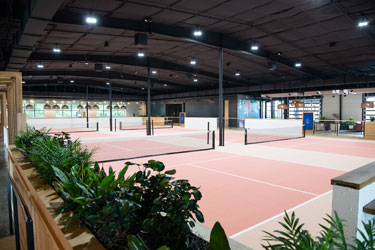
Modular flooring does not have to be permanent, making it an excellent option for use in temporary facilities. It is not difficult to install and costs less than equivalent wooden flooring, said Dwyer. Modular flooring is easy to care for and never requires refinishing. It can be highly customized in terms of color and appearance (even mimicking the look of ice or wood) as well as performance. It can also be used for a wide variety of purposes, not all of which have to be sports-related.
When it comes to installation time, traditional wood flooring can take weeks to install properly. Modular flooring, on the other hand, can be installed in days because of the simplicity of its design. “And here’s something else you might not know about modular flooring,” Dwyer said. “It can be taken up and put away without any special tools. In essence, you can pack up the modular tiles and move them to another location. This is ideal for situations where space is rented or leased.”
Subfloor Systems
The installation process begins with having the correct subfloor system. The basic requirements for installing a modular
brand of indoor sports and fitness flooring would be a solid, flat subsurface for the materials to lay over, preferably concrete, said Jake Angrisano, a sales representative of a Utica, N.Y.-based custom sports floors and modular flooring manufacturer. “This base should have any major heaves or dips leveled prior to the installation of our tile material so these elevation changes do not affect play or player safety. A flat, solid base will provide the proper ball response during play and a safe environment for players.”
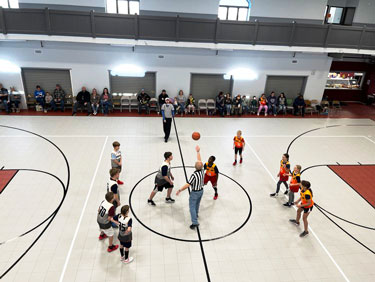
It’s important to have the right subfloor system as well, said Evans. “The MFMA’s manufacturers have spent years testing and developing a host of subfloor systems to meet the needs of athletes and other facility users.”
There are three basic subfloor designs for maple sports floors: floating systems, fixed systems, and anchored resilience. Floating systems are exactly what they sound like, Evans explained. They float over the concrete substrate and are not mechanically fastened to the concrete slab in any way. “Fixed systems are mechanically fastened with anchor pins, screws, adhesives, directly to the concrete substrate,” he continued. “Anchored resilient systems are mechanically fastened to the concrete substrate but have a combination of components that allow varying degrees of additional resilience within the subfloor system.”
Start your specification, Evans advised, by asking questions such as, “Who will be using the floor? What activities will be performed on the surface? How often will the facility be used in an average year? What is the climate in the area of installation? What types of HVAC systems can I specify for the space? Answers to these and other questions will help you eliminate subfloor designs that are inappropriate for your project.”
Multiple combinations of steel, wood, composite metal, plastic, neoprene and rubber are signatures of most anchored resilient subfloor systems, Evans said. Different combinations of those anchored resilient subfloor designs might be recommended by your individual manufacturer that will meet both the needs and design parameters of your project. “Subfloor systems have evolved over the years from a number of generic subfloor systems. Each of these systems have been on the market for many years and have been successfully installed in thousands of facilities worldwide.”
Care and Maintenance
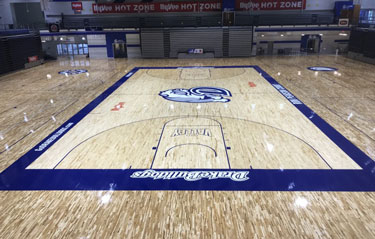
John Gleason, manager of field services for a Utica, N.Y.-based sports flooring manufacturer, advised keeping the room
at a consistent temperature. He also suggested daily dry temperature between 60 and 75 degrees Fahrenheit if possible. “This helps to control humidity in the room and helps to prevent tile expansion issues as well.
Most flooring manufacturers start by recommending use of walk-off mats at all entryways to reduce the amount of dirt and debris coming into the facility, said Gleason. “All flooring will require daily dust mopping and damp mopping or using an automatic scrubber as needed. Hardwood floors generally need yearly screening and recoating. Synthetic flooring will require deep cleaning and restoration annually using the manufacturer’s recommended methods. Many sport tiles require annual deep-cleaning, while some have a protective coating that needs to be reapplied. Each flooring manufacturer will have recommended methods for cleaning and maintaining their flooring products that must be adhered to. The most important thing is to be aware of the maintenance requirements and have appropriate expectations prior to purchasing a floor to be sure your maintenance staff is properly equipped.”
Traditional gym floors require quite a bit of care, Dwyer said. “For example, they not only need to be kept clean regularly but sanded to the bare wood and refinished about every two years. Care should be taken in the choice of cleaners to ensure that the finish is not damaged. Wooden gym floors must be wet cleaned and scrubbed on a regular basis because, over time, a slick film of salt and protein will build up due to sweat from the athletes. As for dust, the use of microfiber dust mops is often recommended. To enhance the appearance of these floors, regular polishing is needed unless the flooring has a matte finish.”
Modular flooring also requires a regular routine of dust mopping and scrubbing to maintain its appearance, similar to that of hardwood flooring, but it never needs to be stripped and refinished.
To protect any gym floor from damage during non-athletic use, a gym floor cover is Dwyer’s recommendation. “It will significantly reduce wear and tear but requires its own maintenance, too. Gym floor covers need to be cleaned after each use. They can often be simply brushed off and spot-cleaned, but mild detergents can also be used as long as the cover is allowed to dry thoroughly before it is stored.” RM



